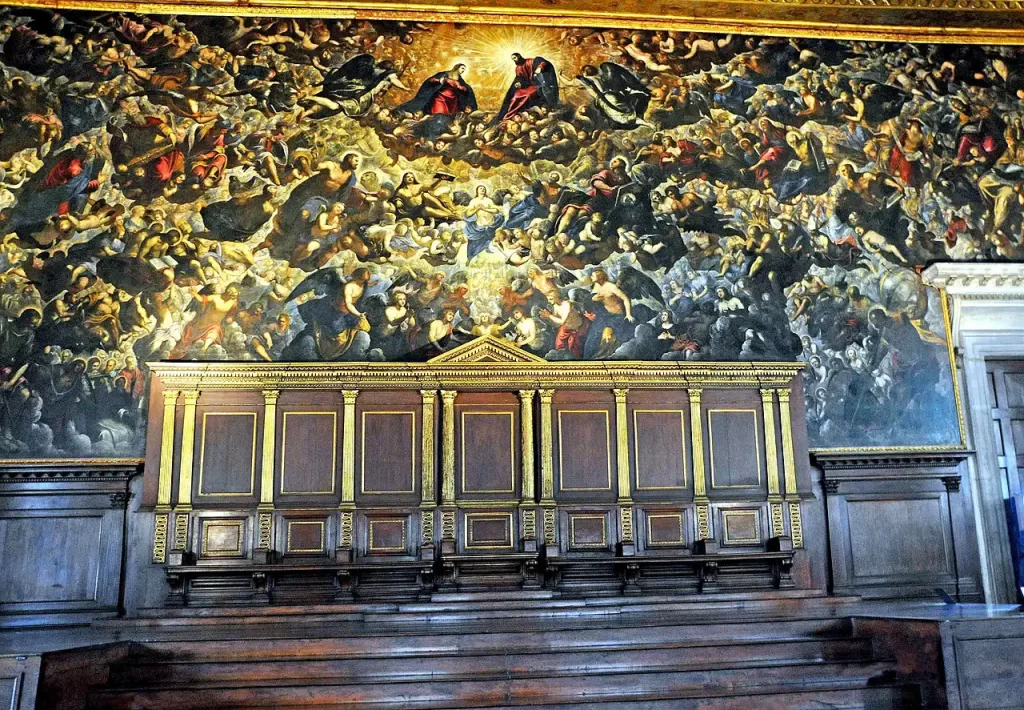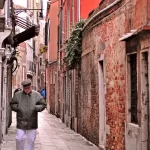Architecture and Facades of Doge’s Palace
The Doge’s Palace is not just a building; it’s a masterpiece that encapsulates the essence of Venetian Gothic architecture. As you approach, be prepared to be mesmerized by its ornate facades, which tell tales of Venice’s grandeur. The fusion of Byzantine, Moorish, and Gothic elements creates a visual spectacle, especially when the sunlight kisses the palace’s intricate stonework.
Strolling around the exterior, you’ll notice the delicate traceries and arched windows that seem to dance with light and shadow. The facade facing the Piazzetta presents a stunning view, with its patterned brickwork and marble embellishments. Whether you’re an architecture buff or simply someone who appreciates beauty, the exterior of Doge’s Palace is sure to captivate your senses.
As you gaze upon the waterfront side of the palace, take a moment to absorb the historical significance of this view. This was the heart of the Venetian Republic, where decisions that shaped the course of history were made. The palace stands not just as a structure, but as a symbol of Venice’s past power and splendor.
The Doge’s Apartments

Imagine stepping into the private world of the Doge, the ruler who once held sway over the Venetian Republic. The Doge’s Apartments in the palace are a journey into the opulence and luxury of Venice’s golden age. Each room is a treasure trove of art and history, adorned with exquisite furnishings and art that reflect the wealth and power of the Doge.
As you wander through these rooms, notice the intricate frescoes and lavish decor that line the walls and ceilings. These were not just living quarters; they were a statement of prestige and elegance. The artistic details here, from ornate carvings to luxurious tapestries, tell stories of a bygone era, of intrigue, and of the immense cultural wealth of Venice.
Don’t miss the chance to peek into the lifestyle of Venetian nobility. The Doge’s Apartments offer a unique glimpse into the personal and political life of Venice’s most influential figure. Each room you enter feels like stepping into a page of history, alive with the echoes of the past.
Institutional Chambers
The Institutional Chambers of the Doge’s Palace are where the gears of the Venetian Republic once turned. These rooms were the administrative heart of Venice, where decisions impacting the entire Mediterranean were made. The grandeur of these chambers reflects the importance of the activities that took place here, with each room outdoing the last in opulence.
Prepare to be awestruck by the masterpieces of Venetian painters adorning the walls. Works by legends like Tintoretto and Veronese not only beautify these chambers but also serve as a narrative tapestry, telling the story of Venice’s power and piety. The grandiose art and intricate ceiling frescoes are not just decorations; they are symbols of the Republic’s might and wisdom.
As you explore, feel the weight of history in these halls. Imagine the Doge and his council in heated debates, shaping the fate of a city that was a maritime superpower. The Institutional Chambers are a testament to Venice’s rich political and cultural legacy, offering a profound connection to the city’s illustrious past.
The Bridge of Sighs
The Bridge of Sighs, or Ponte dei Sospiri, is one of Venice’s most iconic landmarks, steeped in romance and mystery. As you approach this enclosed bridge, you’ll understand why it has captured the hearts and imaginations of travelers for centuries. The bridge offers a poignant view of Venice, with its white limestone and windows with stone bars.
Legend has it that the bridge got its name from the sighs of prisoners catching their last glimpse of Venice through the windows before being taken to their cells. While the truth might be less romantic, the bridge remains a symbol of Venice’s history. As you cross it, there’s a surreal feeling, a blend of beauty and melancholy, that’s hard to put into words.
Don’t miss the opportunity to see the Bridge of Sighs from both inside and outside. From the outside, it’s a picture-perfect spot, especially when viewed from a gondola. Inside, it offers a unique perspective of the city – a view that captivated and saddened many over the centuries. It’s a must-visit for anyone seeking to experience the full range of Venice’s historical tapestry.
The Prisons

The prisons of the Doge’s Palace offer a stark contrast to its opulent rooms. These cells, once home to prisoners of the Republic, give a fascinating insight into the darker aspects of Venice’s history. The prisons are a reminder of the city’s strict governance and the consequences faced by those who crossed the line.
As you walk through the narrow, damp corridors, you can almost hear the whispers of the past. The cells vary in size and comfort, reflecting the social status of the prisoners. It’s
a sobering experience to stand in these cells, imagining the lives of those who were confined here, from common criminals to famous figures like Casanova.
Exploring the prisons is not just about the thrill of the eerie; it’s about understanding the full spectrum of Venetian history. It shows a side of Venice that goes beyond the grandeur, a side that speaks to the human stories and struggles of its past.
Courtyards and Staircases

The courtyards and staircases of the Doge’s Palace are architectural wonders in their own right. The courtyard, with its spacious design and elegant arches, offers a tranquil escape from the bustling streets of Venice. It’s a perfect spot to take a moment and appreciate the beauty of the palace’s exterior up close.
The grand staircases are marvels of design and craftsmanship. The Scala dei Giganti, or Staircase of the Giants, is particularly impressive. Flanked by statues of Mars and Neptune, it symbolizes Venice’s power over land and sea. Climbing these stairs is like walking through a portal to the past, a path once tread by the Doges themselves.
Then there’s the Scala d’Oro, or Golden Staircase, aptly named for its lavish gold decorations. This staircase was once reserved for the Venetian elite, symbolizing their ascent to power. As you ascend, let the opulence and history envelop you, and imagine the countless stories these steps have witnessed.
Art Collections

The art collections within the Doge’s Palace are a feast for the eyes and the soul. Here, you’ll find an impressive array of Renaissance art, each piece telling a story of Venice’s artistic heritage. The palace is not just a museum; it’s a treasure trove of masterpieces, a testament to the city’s love affair with art.
From grand paintings to delicate sculptures, every artwork here is a piece of history. These collections offer a journey through time, showcasing the evolution of Venetian art and the genius of its artists. The works of Tintoretto, Titian, and Veronese, among others, are not just beautiful; they’re powerful narratives of a city that was a cultural epicenter.
As you explore, take the time to appreciate the details in each piece. The play of light, the richness of colors, and the expressions of the figures all tell stories of Venice’s past. This is more than an art viewing; it’s an immersive experience into the soul of Venice.
Guided Tours
To truly appreciate the depth and breadth of Doge’s Palace, consider taking a guided tour. Knowledgeable guides bring the palace and its history to life, providing insights that you might not discover on your own. They’ll lead you through the maze of rooms and corridors, each with its own story, making your visit both educational and fascinating.
Guided tours often include behind-the-scenes access to areas of the palace not open to the general public. This is your chance to uncover hidden gems and lesser-known facts about the palace. From secret passages to exclusive art, these tours offer a more in-depth exploration of the Doge’s Palace.
A guided tour is also a great way to connect with other travelers and share the experience of discovering Venice’s history together. Whether you’re a solo traveler or with a group, a guided tour can enhance your visit, leaving you with a deeper understanding and appreciation of this magnificent palace.











